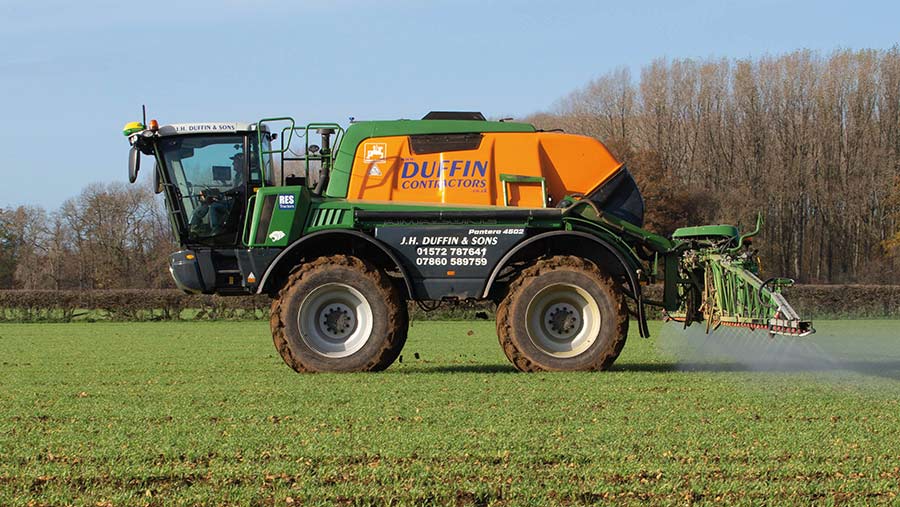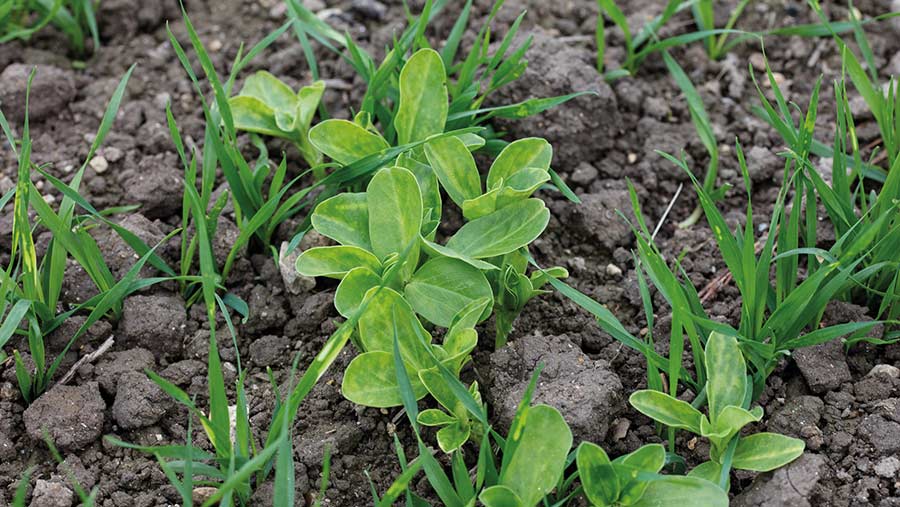Crop Watch: Volunteer beans and barley yellow dwarf virus
 © Tim Scrivener
© Tim Scrivener The tropical autumn continues and with it the ongoing threat of barley yellow dwarf virus in cereals. Large clumps of volunteer beans are being seen in wheat crops with some debate on what action to take.
West: Stephen Harrison
AICC/Southwest Agronomy (Avon)
Weather over the weekend was more akin to April than November, with a record local high temperature recorded. Why do the best spraying conditions fall on a weekend when so much excellent sporting action is taking place?
A large impression was made on any remaining drilling. Despite the downpours, land has turned over dry and good seed-beds were prepared. Conditions were also ideal for contact graminicides on winter wheat.
See also: 5 steps to an integrated approach for tackling fusarium in wheat
The weather has proved ideal for crop growth, I have rarely seen so few poor areas. Winter barley is well tillered and, in some cases, carrying mildew. I shall be waiting to see the effect of any cold weather before treating. Very low-level mildew is also present in the most advanced wheat crops.
Aphids
Figures show that numbers of barley yellow dwarf virus (BYDV) carrying bird-cherry oat aphids are declining and it has been more difficult to find them in crops. If you found aphids and treated earlier, do not forget to add the days of persistence of the insecticide to the 170C day degrees if you find more and need to spray again.
Winter OSR has grown continuously in the wet, mild conditions. It is still too mild for propyzamide, when the colder weather eventually arises it is worth noting that the product still performs well in large canopies providing all other factors are correct.
Fodder beet struggled during a dry establishment period and lack of rain in July and August. Tough weeds needed robust treatments which led to headaches over crop safety on already thin stands. Growers have left them in the ground a little longer to take advantage of the rain and carry-on bulking. Since the rainfall, new leaves are free from mildew which was starting to be problematic.
Winter bean emergence has been unusually rapid, making application of pre-emergence herbicides challenging. Beans are very forward and sustained frosty weather may cause damage.
Large clumps of volunteer beans are in some wheat crops and the lack of mecoprop in the autumn means more expensive control with florasulam-containing products.
East: Becky Finbow
Agrovista (Norfolk/Suffolk)
Although we now have some rain in the east it is still surprisingly mild. With these warm temperatures comes the continued threat from BYDV.
While some farmers are still busy applying their first insecticide, there are some earlier drilled cereals where a second T-sum has been reached, resulting in a further insecticide being recommended.
This autumn it has been easy to find aphids in cereals, and although barley and wheat are the most commonly affected, it is important not to forget that BYDV can also damage oats and rye. Placing yellow sticky traps in the field will also help to determine aphid populations and reduce any unnecessary applications.
Winter beans are now starting to emerge. Where conditions allowed, a pre-emergence herbicide was applied. A mixture of pendimethalin and propyzamide was popular this year to help prevent grassweeds and some broad-leaved weeds. The addition of clomazone added control of cleavers.
Carbetamide
Where pre-emergence applications were not possible, control of weeds may be difficult due to limited post-emergence herbicide options. Where carbetamide (as in Crawler) is on farm this can be applied post-emergence, but avoid the knuckling over stage. All carbetamide must be used up by the end of November.
The extent of beet moth is becoming clear as sugar beet crops are lifted. Pulling a beet root out the ground has shown how far the beet moth larvae have ventured into the root, causing damage as they go.
Typical symptoms include blackening of the crown and the loss of new leaves, but black scarring on the root is also now visible. Trying to pull beet out by the foliage is proving difficult in infected crops as the leaves just pull from the crown easily. Unfortunately, nothing can be done to prevent the beet moth and the damage it causes.
South: Iain Richards
Agrii (Oxfordshire)
Plenty of rain and an upturn in temperatures have transformed any oilseed rape and cover crops which were finding it hard going earlier on, and been very welcome for everything else. But they’ve brought us another set of challenges, resulting in a substantial spraying backlog.
A good 100mm of rain across much of Hampshire in the first week of November brought wheat drilling as well as spraying to a grinding halt. Even so, the last of our wheats should be safely in the ground by the time you read this, joining crops emerging nice and evenly from some of the best drilling conditions in recent memory.
Our pre-emergences – including more cinmethylin than originally planned – seem to be working well, thanks to good quality seed-beds, a particular focus on sowing depth control, effective rolling and, now, a decent amount of soil moisture.
Carefully balancing risk and spend, wherever we’re using more robust pre-ems we’re reining back on our peri-ems. However, we still can’t do without them in most cases.
So, our big challenge at the moment is finding enough spray days; every day we don’t get the peri-ems on being an extra day for blackgrass to escape. If it stays so mild we may even need to think about some sort of post-em follow-up!
Little reliable cold weather on the horizon is adding cereal aphicides to our current spray programme pressure. Especially so, as aphid numbers have built-up noticeably in volunteers in both overwintered stubbles and covers.
Spray list
Also joining the sprayer priority list is growth regulation for very big and tall 7-8 leaf OSR crops that have been revelling in the conditions. Even further ahead than last year, they’re due for a PGR with their autumn fungicide in the form of Architect (mepiquat + prohexadione + pyraclostrobin) as soon as possible.
Thankfully, the Centurion Max (clethodim) we managed to apply before the weather got in the way has nicely removed early grassweed competition, together with the temptation to spray propyzamide before soil temperatures get low enough – which may well not be before Christmas now.
Doing far better than seemed possible just four weeks ago, our OSR companions are showing little sign of dying back yet. But the OSR is growing away from them well and the planned propyzamide plus aminopyralid should finish them off.
Having done almost nothing until mid-September, our cover crops have huge canopies, too. For those with access to sheep, grazing sooner rather than later is the order of the day, limiting this to removing no more than two-thirds of the growth to avoid damaging the soil and losing too much of the nutrients they’ve captured.
The turnaround in their fortunes means effective destruction of these covers as well as the understories of blackgrass many are carrying beneath their canopies will soon become a priority. And a much more challenging one if we don’t get enough frost to open them up first.

© Blackthorn Arable
North: Conor Campbell
Hutchinsons (Northumberland)
Crops continued to be sown in great conditions right through October, which can be a challenging month. The combination of pre- and early post-emergence herbicides have done a great job on early weed control.
Brome would be our biggest challenge this far north and a trend to heavier pre-emergence mixes in winter barley crops showed up in the early stages. These have since recovered, but unfortunately are necessary in the ever-continuing fight against brome.
Barleys have now started their chameleon gig, changing colour from a nice, lush green to yellow and back again. This usually results in a few concerned phone calls, but they will be fine and put this act to bed in the spring.
Growth spurt
Mild conditions have meant that most OSR crops have jumped. This has taken away some of the concern as they head into winter. Any patchy fields are now, unfortunately, obvious and decisions about these struggling areas will need to be made.
Propyzamide applications are ongoing when spray windows allow. Field conditions are the big driver and application windows are pushed as far as we dare, but, ultimately, we need to ensure we can travel. With blackgrass not a major issue, soil temperatures aren’t as critical.
Winter beans emerged very quickly, thanks to warm soils. Where later harvesting is feasible, they provide a great opportunity for effective grassweed management.
Volunteer beans tend to split opinion in the following wheat crop, and striking the balance can be tough. I try to gauge this as best as I can depending on the density of the volunteers. I think there’s something to be gained from the extra root structure and any additional nitrogen, but not if they will compete with the wheat crop.
With strong crops heading into the winter, our attention turns to fertiliser inputs. With the ever-increasing market volatility and prices changing on a regular basis, these decisions are not easy to make.
A drop in the P and K prices due to little movement over the past few months has resulted in, well, more stalemate. Rumours of a nitrogen price drop could result in the same situation.

